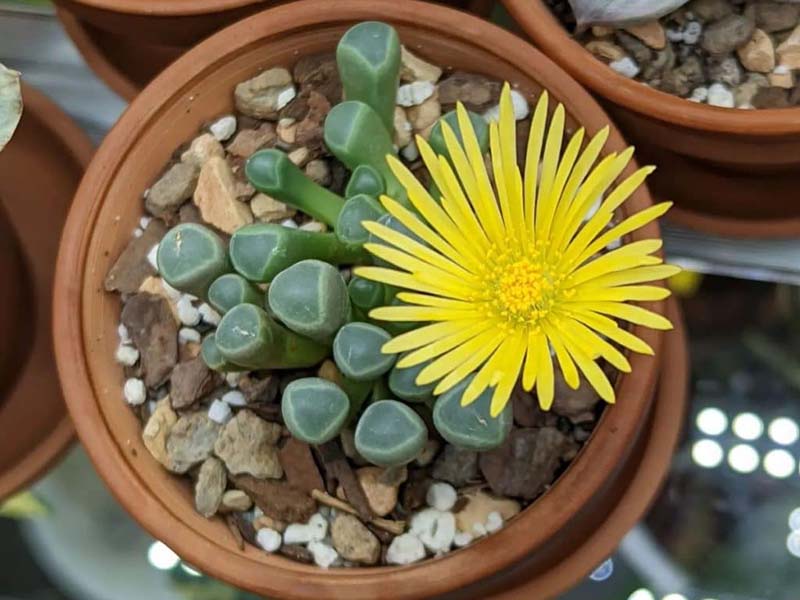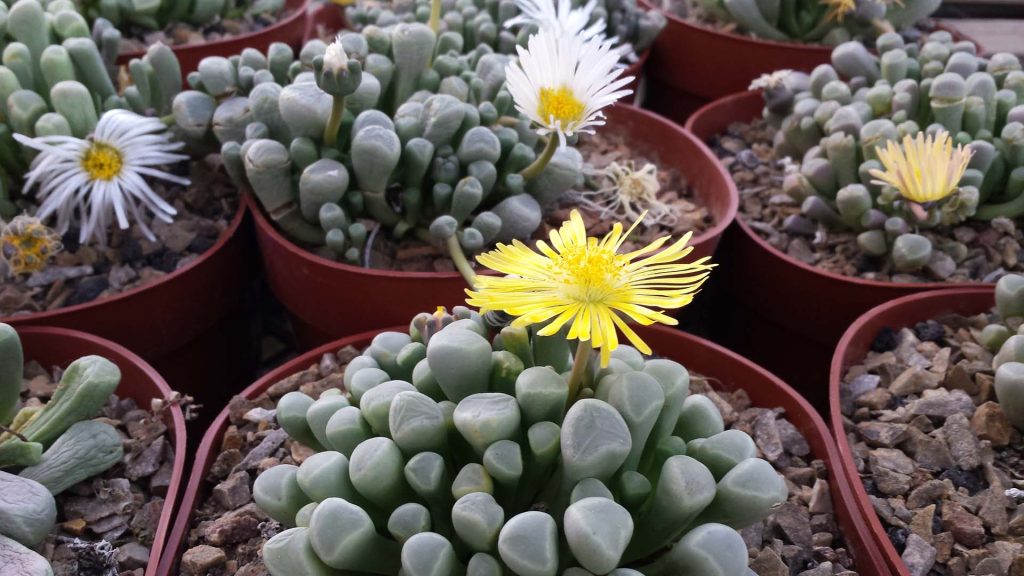If you are looking for cute and unusual plants, the care of which is simple and does not require a lot of time, then this plant should not be left without your attention.
Fenestraria is a monotypic genus with only one species, Fenestraria rhopalophylla, but its subspecies Fenestraria aurantiaca is a candidate for being classified as a separate species of this genus. The color of the flowers is all that distinguishes these plants, and Fenestraria aurantiaca care is completely identical.
Fenestraria is also often called a baby toes plant due to its green, finger-like leaves that grow in vertical bunches. In shape, they resemble small fingers with small bubbles at the top, which are a kind of windows that allow light to pass through and provide photosynthesis. The word “Fenestraria” is derived from the Latin word “Fenestra”, which means “window.” Interestingly, baby toes belong to the Aizoaceae family, which includes the “mimicry plants”, which are named for their ability to camouflage under environmental influences.
This small plant does not grow in height, but in diameter and is usually about 3 in. Baby toes succulent leaves can grow up to 2 in. The flowers are of different heights but resemble chamomile with many small and elongated petals.
The flowering process usually begins in August and ends around March, however, this process is strongly influenced by the health of the plant, its access to good lighting, and ventilated space.
Characteristics of the Baby Toes Plant
Physical Appearance

The Baby Toes plant has small and soft succulent leaves that are shaped like a toe, hence the name. The plant grows up to 4 inches tall and 6 inches wide. The leaves are translucent and can range from light green to bluish-green, depending on the species. The plant also has small flowers that bloom in the late winter or early spring. The flowers are white, yellow, or pink and have a pleasant fragrance.
Growth Requirements
The Baby Toes plant is an easy-to-grow plant that requires minimal attention. It prefers well-draining soil, bright but indirect sunlight, and low to moderate humidity. The plant thrives in warm temperatures, with an ideal range of 65 to 80 degrees Fahrenheit. However, it can withstand temperatures as low as 50 degrees Fahrenheit. The plant is also drought-tolerant, but it requires occasional watering during the growing season.
Cultivation Tips
To cultivate a healthy Baby Toes plant, you should use a well-draining soil mix that consists of sand, perlite, and peat moss. The soil mix should be pH balanced and slightly acidic. You should also ensure that the plant is not overwatered, as this can cause root rot. To prevent overwatering, you should allow the soil to dry out completely before watering again. Additionally, you should avoid fertilizing the plant during the dormant season, as this can lead to poor growth.
Care for Baby Toes Plant
To pick up the most suitable care, it is necessary to take into account its natural habitat and the structure of the plant. The baby toes cactus is native to the arid region of Namibia and South Africa, namely Namaqualand. Accordingly, the plant has adapted to the harsh habitat and even developed the ability to partially grow underground. Now let’s find out what care for baby toes succulent should be.

Lighting
For better growth, the plant is provided with bright light for at least 6 hours a day. It is worth protecting from direct sunlight, as this can significantly harm and provoke sunburn. The best option would be to place the plant by the south window. With a lack of light, the leaves stretch in length; the plant is depleted and deformed.
Watering
The water need occurs when the soil is dry to the touch. You can easily check this by simply dipping your finger into the soil. But during hibernation (at the height of summer), watering should be minimized or stopped at this time at all.
One of the advantages of Fenestraria is that it is a good communicator, so you will immediately notice if you do something wrong. Because of the excessive amount of water, the tips of the leaves usually begin to crack, and the leaves turn yellow. In case of lack of moisture, you will notice shriveling baby toes succulent.
Pot and soil
Fenestraria succulents are like cacti when you face soil selection. Using ordinary potting soil with humus or peat moss is not desirable as the plant will not grow well. The soil should consist of perlite and sand, as well as pumice, and the pot should have holes in the bottom so that the accumulation of excess water does not become a problem.
The pot size for this succulent usually varies depending on your needs. You can easily plant Fenestraria next to other succulents with similar care needs in the same pot, thus creating an interesting and unusual ensemble of several plants.
Reproduction
Reproduction of Fenestraria succulents can be done both by seeds and by cutting off the shoots. It is worth mentioning that for most gardeners and succulent growers, the cutting method is preferred since growing from seeds will take a lot of time and does not give a guaranteed result. However, if you want to try sowing seeds, you must plant them in the fall. Also, cover the seeds with sand to provide a more favorable environment. If you live in colder climates, then use a lamp for growing so the plant is more likely to take root. After planting the seeds, cover the container with plastic wrap to keep it dry and warm. Store seedlings in a less lit environment with a constant temperature of at least 66 °F.
In order to propagate the plant with the cuttings, it is sufficient to either carefully pull it out of the soil (it is considered a little riskier since you can damage the root system), or cut it off with a clean, sharp knife. Before using one of these methods, make sure that the plant has grown at least 1 in. After you have cut the shoot, you must leave it to dry for 3-4 days on a sheet of paper or napkin, and only then can you transplant it in a pot with drainage holes.
Fertilizers
Fertilizers, which are commonly used for growing cacti or succulents, can be applied if you find the Fenestraria needs feeding. However, fertilizers should be applied only in small doses and during the active period.
Flowering
If the environment is comfortable for the Fenestraria succulent and it gets enough water, it will bloom odorless white or yellow flowers. The number of flowers that a succulent can form varies from 1 to 4 at the same time. Once the flowers start to wilt, you must remove them by cutting off the stems so that your succulent plant can resume its growth process.
Temperature
The succulent plant is not quite picky about temperature and can withstand a fairly wide range of temperatures. It will perfectly endure the summer heat and a light frost will not be a problem. The only thing to remember is that at low temperatures it should be kept dry and refrained from watering, otherwise you can harm the plant.
Benefits of the Baby Toes Plant

Decorative Purposes
The Baby Toes plant is an excellent addition to any indoor or outdoor garden. The unique shape and color of the plant make it an attractive and eye-catching addition to any space. The plant can be grown in pots or containers, making it an ideal plant for small spaces. Additionally, the Baby Toes plant can be used in terrariums or miniature gardens, adding an element of creativity and diversity to the garden.
Health Benefits
Apart from its decorative purposes, the Baby Toes plant has several health benefits. The plant is known for its ability to purify the air and remove toxins such as formaldehyde, benzene, and trichloroethylene. The plant can also increase the humidity in the surrounding air, which can help to alleviate respiratory issues such as dry coughs, sore throats, and nasal congestion.
Therapeutic Properties
The Baby Toes plant is also known for its therapeutic properties. The plant can help to reduce stress and anxiety levels, leading to an overall improvement in mental and emotional well-being. The plant can also help to improve concentration and productivity, making it an ideal plant for home offices or workspaces.
Final Verdict
Thus, it is a great option for those looking for unusual plants that do not require complex maintenance. Fenestraria can be grown both indoors and outdoors. Due to their unusual shape and small size, Fenestraria succulents can easily become an object of interest in any room or garden. These succulents are quite easy to grow and require a little because their natural habitat is dry and sandy, where they like to camouflage on sandy ground and pretend to be pebbles on the ground. We assure you, this plant will not leave you indifferent.


